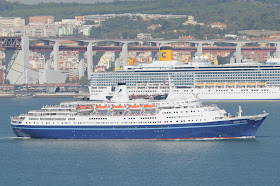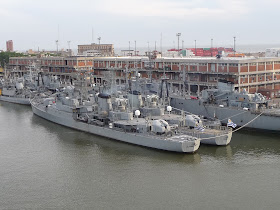 T
Terry Hutson's Report (
PORTS & SHIPS): The maritime professionals’ union Nautilus International says in a statement issued yesterday that Friday night’s grounding of the cruise ship COSTA CONCORDIA carrying 3200 passengers and a crew of about 1000, just two weeks into the Titanic centenary year, should serve as a wake-up call to the shipping industry and those who regulate it.
Nautilus – which represents 23,000 ship masters, officers, ratings and other shipping industry staff – says the incident involving the Italian-flagged cruise ship off the Italian coast is the latest in a series that have highlighted its long-standing concerns over safety.
By late Sunday five people were confirmed dead and another 15 remained missing. Earlier a honeymoon couple from South Korea were rescued from low down in the ship where they had been trapped and unable to make their way up onto the decks with other passengers. At least one other person remained on board waiting to be rescued. Search parties heard him yesterday calling for help but hadn’t yet managed to locate or identify the man.
Rescued passengers told of panic and chaos on board the ship, and claimed that regulation lifeboat drills had not bee carried out but were scheduled for the next morning.
“In this, the centenary of the loss of the Titanic, major nostalgia industry is already in full flow – but it is essential that everyone recognises that the Titanic offers lessons for today and that there are contemporary resonances that should not be lost,” said Nautilus’ general secretary Mark Dickinson.
In particular, Nautilus says it is concerned about the rapid recent increases in the size of passenger ships – with the average tonnage doubling over the past decade.
“Many ships are now effectively small towns at sea, and the sheer number of people onboard raises serious questions about evacuation,” Mr Dickinson pointed out.

“Nautilus is by no means alone in voicing concern at underlying safety issues arising from the new generation of ‘mega-ships’ – whether they be passenger vessels carrying the equivalent of a small town or containerships with more than 14,000 boxes onboard. Insurers and salvors have also spoken about the way in which the sheer size and scale of such ships presents massive challenges for emergency services, evacuation, rescue, and salvage - and we should not have to wait for a major disaster until these concerns are addressed.
“The growth in the size of such ships has also raised questions about their watertight integrity and fire-fighting protection,” Dickinson added. “In an address to a conference on the safety of large passenger ships in 2000, the then secretary-general of the International Maritime Organisation, William O’Neil, cited 12 passenger ship accidents in the previous six years and noted “…in retrospect we can see that it was to some extent a matter of luck – good weather, calm seas, and other ships in the vicinity, for example – that very few lives were lost.”
“We believe that more attention needs to be given to such issues as the adequacy of life-saving appliances, and the quality and quantity of crews and their training and experience in operating these vessels and dealing with emergency situations, including evacuation,” Mr Dickinson said.
According to Nautilus it is essential that inquiries into the Costa Concordia grounding examine reports of an electrical problem onboard – an issue on which the union raised concern following an explosion and loss of power onboard Cunard’s Queen Mary 2.
It is essential that ships are built for safety, with adequate redundancy rather than a prescriptive minimum, the Union argues.
It says the inquiries should also address human factor issues including seafarers’ working hours and adequate manning of bridge and engine room. Investigations also need to focus on crew competence and training issues.
The Union is calling for a thorough review of regulations governing the construction and operation of passenger vessels - in particular, standards of stability and watertight integrity. Attention needs to be paid to existing evacuation systems and more innovative systems for abandonment.
Yesterday the BBC reported experts as saying they are puzzled as to why such a modern and well-equipped vessel should have run aground in well-charted waters.
The report described the ship as having been in calm waters sailing along a familiar route. The mystery is why it diverted from its course by between 3 and 4 miles, and why the ship capsized so quickly. “This will be central for investigators trying to establish the cause of the accident.”
It says the investigation will focus on why a modern ship, “with the latest safety equipment, travelling on the same route it travels 52 times every year, seemingly veered off course and hit what the cruise company has described as ‘a big rock’.
“There are a large number of possibilities ranging from human error, to technical failure, to a combination of the two. “It is possible the crew simply made a mistake and steered off course. They may have been misled by faulty navigation equipment.” The ship’ master is reported to have said that the rock which the ship hit is not on any chart currently in use.
What is known is that the accident occurred while some passengers were still at dinner in the various restaurants. Others were being entertained at a magician’s show in the theatre up in front of the ship. When the collision occurred and the ship began to list, the magician disappeared and some passengers said they thought it was all part of the show.
Others would have been in their cabins or staterooms, or on deck. Passengers described a long rumbling grating noise coming from underneath the ship. It was later discovered that a 41m gash had opened part of the lower hull, admitting the sea and leading to the ship ultimately capsizing. The collision was followed by all electrical power being lost, which added to the chaos among passengers. About an hour later, with the ship’s list becoming pronounced, the order was given to abandon ship but by then the list was too great for lifeboats on one side to be lowered.
A number of passengers or crew jumped overboard amid some reports of panic among passengers. Later reports said the master of the ship had left the vessel before all his passengers were safely in lifeboats or had been lifted ashore.
The captain, Francesco Schettino, and first officer, Ciro Ambrosio, have meanwhile been arrested and could face multiple homicide charges and having abandoned the ship before the passengers were rescued, the Italian police and media reported.
Costa Cruises, the Carnival Corporation division that operates the Costa Concordia has begun to apportion the blame, saying “It seems that the commander made errors of judgement that had serious consequences,” while adding that he had not followed company procedures in his management of the emergency.
Carnival Corporation, the owner of Costa Cruises said in a statement that it was deeply saddened by the accident and was working to fully understand the cause of what happened.
It said that “on 13 January 2012, Costa Cruises’ vessel, the Costa Concordia, departed from Civitavecchia, Italy with approximately 3,200 passengers and 1,000 crew members on a seven-day voyage. At approximately 10:00pm CET, the vessel struck [a] rock off the coast of Isola del Giglio, Italy and sustained significant damage causing the ship to list severely. The order was given to abandon ship and deploy the lifeboats.”
One of the drawbacks of accident enquiries is that they are conducted by the flag state concerned – in this case Italy. With passenger ships such as Costa Concordia carrying a large number of people from other parts of the world it might be preferable if a neutral body was appointed by the IMO to look into such incidents and accidents. There is sometimes too much national pride involved for total confidence that all flag states will set about understanding and explain all the relevant facts.
An accident such as this one can take up to a year before the inquiry reports are completed, despite the existence of a so-called ‘blackbox’ which contains a large amount of technical and human information up to the moment of the collision and capsizing. This includes voice monitoring from the bridge. Source BBC, Nautlius, Paul Ridgway (London) and own source
Texto e imagens /Text and images copyright L.M.Correia. Favor não piratear. Respeite o meu trabalho / No piracy, please. For other posts and images, check our archive at the right column of the main page. Click on the photos to see them enlarged. Thanks for your visit and comments. Luís Miguel Correia



















































